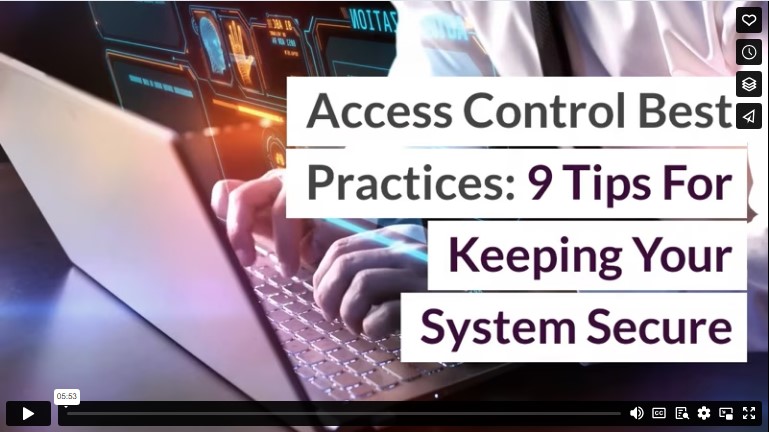What’s the state of access control in your organization? Often, it’s an overlooked aspect of cybersecurity. Many companies either undervalue its importance or are unsure how to manage it. This post covers nine best practices for improving access control in your organization.
1. Prioritize Weak Areas
Implement access control with a purpose, not just as a routine task. Assess how it can improve your system’s security. Begin by pinpointing your network’s weak spots. Which areas are most prone to security risks?
Suppose you discover your user authentication is too lenient. You might need to upgrade to multi factor authentication or enhance password protocols.
Tackling these specific vulnerabilities head-on can significantly boost your system’s defense. Each targeted action strengthens your security framework, making your system more resilient against potential threats.
2. Automate User Provisioning
Automating user provisioning is another key best practice. Many companies still monitor access manually, a method that often overlooks crucial security issues. Automated provisioning establishes policies and integrates them with IT systems. It also streamlines the approval process for access requests.
Additionally, companies using automated provisioning benefit from access rights being accurately matched to employee roles. This strategy not only strengthens security but also improves efficiency in managing access across the organization.
3. Implement Multiple Security Layers
Adding multiple security layers significantly bolsters access control. Think of it as not just relying on a single checkpoint. This approach proactively fortifies your system against cyber threats.
Essentially, more layers translate to a tougher defense system—making it far more challenging for unauthorized access to occur. It creates a series of barriers an attacker must clear. Each layer they encounter ramps up your system’s security. This strategy ensures your system’s safety is comprehensive and robust.
4. Align Access Controls with Industry Regulations
The access controls your company needs depend on your IT setup and regulations. Tailor these controls to fit your specific environment.
When setting up access controls, look at your industry regulations. In healthcare, for example, protecting personal health information is imperative. Financial firms focus on securing financial data.
Different industries and regions have their own rules. Match your access control to these requirements. Doing so ensures both compliance and effective protection of sensitive data.
5.Use Multi-factor Authentication
Multi-factor Authentication (MFA) boosts access control by asking for more than one proof of identity. This method adds several layers of defense, making unauthorized access much harder.
MFA involves three types of checks.
- The first is knowledge-based, like a password or PIN.
- The second is possession-based, involving items like a security card or smartphone. Banks often use this for one-time passwords.
- The third type is biometric, using unique personal features like fingerprints.
MFA’s strength comes from these combined layers. If someone gets your password, they still can’t access your system without your fingerprint or security token. This makes MFA a robust security tool.
6. Consider Identity and Access Management
Identity and Access Management (IAM) is all about understanding and managing each individual’s access within a company.
Here’s how it works: An IAM system keeps a detailed record of every person’s role and access requirements. It ensures that each person has easy access to data appropriate and necessary to perform their duties. IAM denies access to sensitive data not applicable to an individual’s role within the corporation. It also serves to keep hackers from accessing sensitive information.
The advantages of IAM are clear. It provides stronger security, streamlines user management, ensures compliance with data protection laws, and simplifies user experience with features like Single Sign-on.
7. Secure Administrative Access
Securing administrative access is critical in an organization’s access control strategy due to the high privileges of admin roles. Administrators have wide-reaching access, making their accounts attractive targets for cyber attackers.
Best practices for securing admin access include:
- Least privilege principle: Limit administrators to minimum necessary privileges and encourage using non-privileged accounts for routine tasks.
- Credential management: Regularly update and rotate administrative credentials. Automated systems can enforce password complexity and routine changes.
- Activity logging and monitoring: Log and monitor all administrative account activities, including login times and accessed files, to create an audit trail for detecting misuse and aiding in forensic analysis.
8. Adopt Cloud-based Access Control
Embrace cloud-based access control for flexibility and efficiency. This system permits remote management, a must-have in today’s mobile-centric world. It seamlessly integrates with other security systems for enhanced protection.
Cloud solutions scale with your business. They manage more users and entry points as you grow. Plus, real-time updates provide instant security insights.
This method transforms traditional access control. It offers a dynamic, adaptable solution for modern business needs.
9. Implement PDK Access Control
Opt for PDK (ProdataKey) for cutting-edge access control. It offers mobile credentialing and wireless door access, simplifying the entire process.
Known for easy setup and user-friendly interfaces, PDK is perfect for tech-forward businesses. Its mobile-centric design aligns with contemporary workplace dynamics.
Choosing PDK is a step towards streamlined, tech-savvy access control. It aligns access management with modern business requirements.
Conclusion
Controlling access to your systems and sensitive data is the goal of all your cybersecurity efforts. Achieving this goal begins with implementing the above strategies to enhance your organization’s access control. Each plays a crucial role in fortifying your defenses. Implementing these methods will lead to a more secure, streamlined, and adaptable access control framework.
Video
Infographic
Access control is crucial for cybersecurity but often neglected. Several companies either underestimate its importance or are unsure how to handle it. This infographic lists nine effective methods to enhance access control in your organization.





